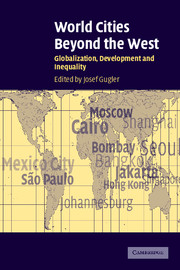Book contents
- Frontmatter
- Contents
- List of figures
- List of maps
- List of tables
- List of contributors
- Acknowledgments
- World cities beyond the West
- Introduction
- Part 1 The impact of the global political economy
- 1 Shanghai: remaking China's future global city
- 2 Seoul: complementing economic success with Games
- 3 Bangkok: evolution and adaptation under stress
- 4 Cairo: too many people, not enough land, too few resources
- 5 Mexico City in an era of globalization and demographic downturn
- Part 2 The impact of the state
- Part 3 The impact of popular movements
- Afterword
- Index
- References
3 - Bangkok: evolution and adaptation under stress
Published online by Cambridge University Press: 12 October 2009
- Frontmatter
- Contents
- List of figures
- List of maps
- List of tables
- List of contributors
- Acknowledgments
- World cities beyond the West
- Introduction
- Part 1 The impact of the global political economy
- 1 Shanghai: remaking China's future global city
- 2 Seoul: complementing economic success with Games
- 3 Bangkok: evolution and adaptation under stress
- 4 Cairo: too many people, not enough land, too few resources
- 5 Mexico City in an era of globalization and demographic downturn
- Part 2 The impact of the state
- Part 3 The impact of popular movements
- Afterword
- Index
- References
Summary
Bangkok, the dominant city in Southeast Asia by 2003, and the political capital of Thailand has experienced high levels of stress since the early 1980s, associated both with periods of very rapid economic growth, and economic crisis. This assessment focuses on the adaptive behavior of key stakeholders that significantly influenced the economic, social, and environmental performance of the Bangkok urban region over that period.
Bangkok was at the center of a severe recession in Thailand in the early 1980s, peaking in 1984, that forced the national government completely to reorient its closed, import-substitution development strategy to one of openness and export-oriented manufacturing. Yet by the late 1980s and early 1990s, Bangkok was one of the fastest growing urban economies in the world, growing at an annualized rate of 17.2% between 1990 and 1996, a rate surpassed during that period only by coastal Chinese cities. The Extended Bangkok Region (EBR) became the engine of the post-1984 boom, known as the “Golden Age of Manufacturing,” driven to a considerable extent by foreign direct investment (FDI). But, domestic financial mismanagement, in the context of rapidly changing and volatile conditions associated with rapid liberalization of global economic, financial, and trading systems, resulted in Bangkok being ground zero in the Asian economic crisis that started in July 1997. By 1999, Bangkok's economy had returned to positive growth but at a much lower rate – approximately 3 to 5% (annually) from 1999 to 2000 (World Bank 2001, fig. 3, p. 3).
- Type
- Chapter
- Information
- World Cities beyond the WestGlobalization, Development and Inequality, pp. 82 - 118Publisher: Cambridge University PressPrint publication year: 2004
References
- 1
- Cited by

